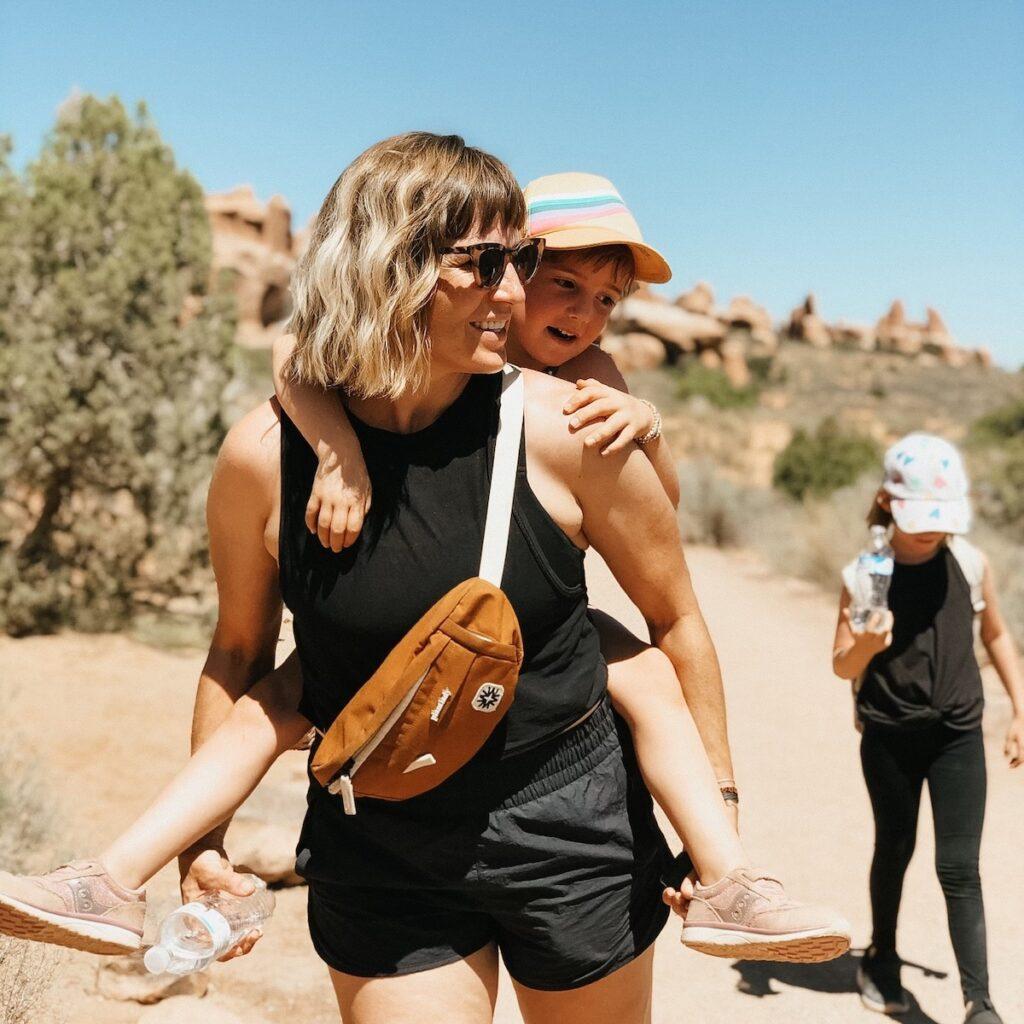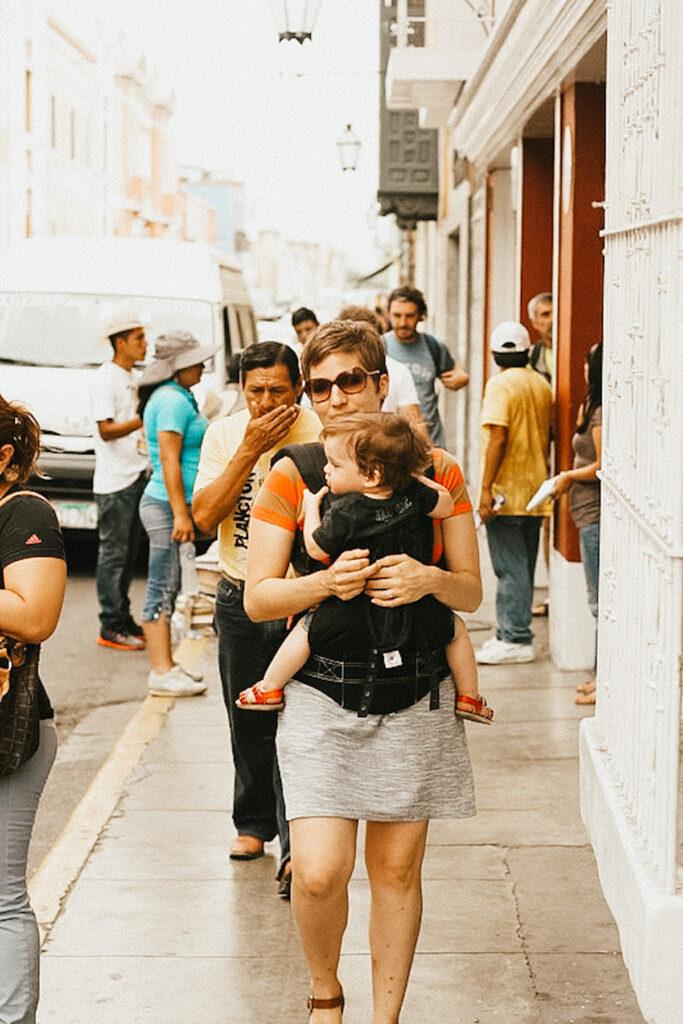Candice McCoy is the founder and editor of The Great Wanderlust, a place to find camaraderie with other women who thrive in adventure and choose the off-the-beaten-path in travel and in life.
She and her partner Jon, along with their four children—two sets of twins now 8 and 10—embarked on their first transformative journey in 2020 to explore slow travel and embrace a more nomadic lifestyle.
Fueled by a desire to break free from conventional routines, they began to embark on remarkable adventures, showcased through their blog series, Wander Here. Candice, an avid photographer, skillfully captures the essence of their destinations, using her lens to convey the unique experiences they encounter.
The Great Wanderlust also showcases insightful narratives through in-depth interviews with inspiring women—blog-style, and (hot-off-the-press!) in podcast form—titled She, Who Wanders.
We connected with Candice while she was “off” the road for just a minute at her home base in Oklahoma City. Her story is a testament to the power of wanderlust and the pursuit of meaningful experiences.

Wander: How do you manage to maintain a sense of stability and balance when your family is on the move?
Candice: It is so important for us to maintain a sense of stability and routine when we’re travelling, especially when we’re gone for longer periods. It’s essential for my husband and me, and probably even more so for the kids! When everything around them is continually changing, it’s beneficial to have things they can depend on to stay grounded.
One thing we do right away at any new place is unpack our things. Pulling everything out of the duffels and organizing it into drawers makes it feel more homey and less like we’re just visiting someone else’s house (even if that’s exactly what we’re doing).
We also love to hang onto some of our normal routines. We often use mornings to do chores like laundry and cleaning up and then have our book learning time, just like at home. After lunch is when we get out and explore, often staying out until sunset. Weekly rituals like family movie night and Sunday morning pancakes go a long way too!
While keeping normal routines going helps our kids a lot, creating new rituals and routines specific to the places we visit is also really special. During our month in Portugal last year, our kids found an electric tea kettle, something that they had never used before. They loved making iced mint tea every morning, and we all feel a special nostalgia anytime we make tea at home now. So many memories are tied to that kettle’s whistle.

What does “slow travel” mean to you and your family?
To us, slow travel looks like visiting a particular place for a sustained period of time so that we can really dig in and feel connected to the people and culture. But it’s not just about the length of the stay. It also means slowing down, engaging in conversations, and opening up time just to wander and discover things you might not catch when rushing from place to place.
There are so many benefits we’ve found with travelling slow. It allows us to keep our routines but still be able to explore everything we want to see. It also allows for plenty of rest, which is so important, especially for the kids. We’ve found that when we travel fast and are constantly moving from place to place, we wear down quickly, which is less fun and just not sustainable.
We also love how slow travel gives us plenty of time to really experience and learn as much as we can about a culture. Settling in and trying to live like the locals gives a more profound understanding of the intricacies of life there. We don’t want the touristy, surface version of these villages and cities; we want the raw and authentic version that you can only find by having time to wander and do real life there. We believe this fosters empathy and awareness in our kids and gives them a broad worldview.
We wandered around Porto, Portugal, for an afternoon last summer, looking for a broom shop we’d heard about. We’d heard it inspired J.K. Rowling in her writing of the Harry Potter series, but when we found it on a tiny road off the beaten path, I knew it would be about so much more to us.
We spent an hour chatting with the owner, whose great-great-grandfather started the handmade broom and brush shop 50 years before. It was still run as a family business, and the owner happily shared all about the art of brush-making (escovaria) and how his shop has continued to thrive over the generations.

Can you share an example of a cultural exchange or interaction that significantly impacted your children’s understanding of a particular community or place?
Oh, there are so many! From a chat on the street in Paris with a local man who offered to take our picture to the ladies at a community library in Puerto Rico who shared all they’re doing to help local children fall in love with reading. Everywhere we go, we look for opportunities to have conversations. Hearing personal stories is the best way to learn more about a culture and way of life and let it seep into your senses.
In Nazare, Portugal, we were able to stumble through a conversation (hand motions and the tiny smidge of Portuguese we knew) with a local elderly woman who was selling dried fish on the beach. For decades, her husband has been going out to fish in the mornings, bringing home buckets of fish and octopus for her to skin, salt, and lay out on racks to dry in the sun.
It’s an age-old practice that used to be a huge part of the economy of this little seaside village. Seeing my kids’ eyes light up at hearing her story and actually getting to see, feel and taste the fish was eye-opening for all of us and a memory I won’t forget.
The great wanderlust vibe seems to emphasize sustainable and responsible slow travel. Are there any initiatives or practices you actively incorporate to have a positive impact on the environment and local communities?
During our travels, we are passionate about seeking out opportunities to learn more about conservation and how to take better care of our planet. Spending time in nature and getting up close and personal with different ecosystems – from the ocean to the desert to the mountains – helps us understand more tangibly how much our planet needs us to make changes and what we can do to help.
We love to visit places like the Rainmaker Conservation Park in Costa Rica, where 80% of the property is untouched rainforest, hosting one of the most biologically diverse properties in Central America. Visiting places like this fosters curiosity and passion for taking care of our planet.
We are not experts on this topic, but we believe asking better questions together with our kids and listening to the voices of the people who intimately know these local environments is a great place to start.

Is there a place you’ve visited that has become a personal favourite or holds a special place in your heart(s)?
It’s tough because every place we’ve spent significant time in has touched us and holds a place in our hearts. That’s the only downside to slow travel, you feel like there are little pieces of your heart left at places thousands of miles away, which is beautiful but also can feel heartbreaking at the same time.
If I had to choose one place though, it would be Costa Rica. It was the first place we experienced slow travel, and we fell hard for its beautiful culture and way of life. The Costa Rican motto is “pura vida,” which means “pure life.” You can’t spend time there without the pura vida way of life stealing your heart and making you never want to leave.
It’s a slower pace of life, emphasizing nature and not worrying about the little things that don’t matter. And, of course, the landscapes and wildlife are breathtaking.

What advice would you give to families contemplating a similar path of long-term travel and exploration?
You’ll never regret travelling and exploring more with your family. I think the biggest thing that can hold people back from hitting the road is the unknown nature of travelling, especially with kids. It can be intimidating to take the risk, not knowing how it will go. But the thing is, life can be chaotic with kids, even when we’re at home. So you might as well be exploring and experiencing a new place while managing it all.
We’ve had cancelled flights, rental car breakdowns, Airbnbs that didn’t quite match the description, and a crazy diaper blowout in the middle of the Chinese subway. And even though there were uncomfortable moments, it all worked out fine and ended up being some of our favourite memories. Travelling and going on adventures bond you together in a unique and special way. Just don’t let the what-ifs stop you from taking the leap.
We have built our businesses where we can work while on the road, but we still understand it’s a privilege to be able to take longer trips to faraway places. I want to spread the message that you don’t have to go far to experience these adventures.
We have also had incredible experiences and made the best memories taking little day trips around our home state. Just setting out on the road with the whole day open for whatever adventures present themselves is magic, no matter how far away you are.
Wander with Candice

She, Who Wanders is a podcast about pushing boundaries, embracing risks, and creating a vibrant existence that’s true to our deepest values. Each week, you’ll hear the stories of women like Sarah, who sold everything to travel the world, Tiffany, who is bravely navigating the tension between grief and joy, and Christina, who turned her passion for travel into an impactful business that has enabled her family to experience living in dozens of countries together.


